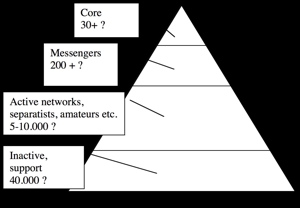After a week with two very interesting lectures on Al Qaeda I have had my outlook somewhat freshened up on this topic that pervades so much of contemporary strategic and intelligence studies.
Bottom line is basically: Al Qaeda is not what it is portrayed to be. The threats are there, but they are not so grand in terms of danger to your life, rather in terms of mass panic. And it all has to do with the organisation of the group.
The first lecture was held by
Michael Clarke (links to a PDF of the excellent magazine The World Today), Director of International Policy Institute at King's College London.
One of the most interesting things that mr. Clarke touched upon was the layout and fragmentation of Al Qaeda - their organizational diagram.
Their top echelon is very tight - 30+? perhaps.
Under them a network of messengers - electronic communication is not trusted - satellite phones especially, as you might imagine. These messengers number around 200+?.
The bottom of the pyramid consists of various groups and separate networks of 5-10.000 active fighters, amateurs, separatists in various groupings and cells.
Furthermore there are perhaps 40.000 inactive, supportive people.

This layout means a fragmentation of missions and members. Bin Laden does not control every mission - it has become a franchise. This on one hand means that attacking groups act independently and it will be hard to track Bin Laden down. On the other hand it means that separatist groups, criminals and kids from Brixton or Gellerup who claim a franchise in Al Qaeda might seriously dilute the spiritual discipline and damage the cause. Beslan is a horrific example of this.
Furthermore the top echelon's analysis of Western Society is flawed. It is build on a quasi-Marxist notion of attacking symbols of control and power as a mean to break down the resistance. But instead of a machine that can be broken Western Society is water that will run around the stone thrown into it.
The real problem here is the Western societies and their risk adversity.
This is very much in keeping with the second lecture. This was held by the Observer's
Jason Burke who has written on Al Qaeda.
The main point of interest in his lecture was the historic development of Al Qaeda. By a very subtle semantic gesture, he linked the literal meaning of the name Al Qaeda in Arabic with its development. 'Al Qaeda' is a common Arabic word that among other things can mean "Vanguard", "(Logistic) Base" and "Methodology" or "Maxim".
Vanguard-Phase. Mid 80s - 1996
A number of individualist, radical vanguards headed back from Afghanistan to foment an Islamic movement and revolution in their home countries. These were great leader figures like Khalid Sheik Mohammed, Ramsey Yusuf and Bin Laden. Al Qaeda was not an organization but a broad network.
Base-Phase. 1996-2001
Bin Laden returns to Afghanistan and sets up a physical environment for terrorist training and revolution. This becomes an essential hub for Bin Laden's network.
Methodology/Maxim phase. 2001-
There is no longer a safe-haven in Afghanistan. The various groups get more and more autonomous and act in a way that they think Al Qaeda would act. There was no genuine contact between the bombers of Madrid and Bin Laden but they did it in the Bin Laden maxim.
Bin Laden is basically sidetracked and does not have much of a capability any more. And it doesn't really matter as his Maxim lives on. However, the missions that the individual groups partake in does not have any guarantee of Bin Laden's genuine eye for symbolic terrorism and 'propaganda of the deed' - Beslan and Madrid again.
In Burke's view the West does not understand or heed this structure. Therefore the Media happily apply the label 'Al Qaeda' to all the sub-groups even though it is highly contended that they really are. The government and security services plays along with this as they are confused or just poorly coordinated. This skewed focus is not intentional from the official side, or in other words, it is 'a cock-up rather than a conspiracy'.
The fact is that Al Qaeda has become an 'empty signifier' - a term that can hold any kind of meaning that you put into it. Thus the organizational diagram above is Al Qaeda and is not Al Qaeda, depending on who you ask.
I think that these two notions of Al Qaeda are very important when analyzing the communication of Al Qaeda as I have tried on this page. It becomes clear that there do not have to be any cohesion of any kind between the beheading movies of Iraq and Bin Laden's video speeches. Therefore it gives perfect sense I think when I characterise Bin Laden's October 2004 speech as an attempt to work over his persona, to style himself as a kind of 'statesman' - that is actually the logical move for a largely impotent head of a chaotic pyramid. (The essay is forthcoming - a link will be given on these pages).



